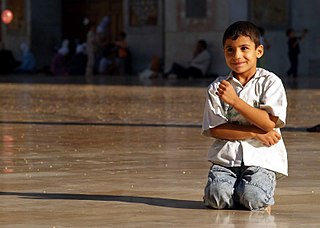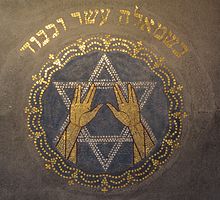Testimony is a solemn attestation as to the truth of a matter.
A teaching method is a set of principles and methods used by teachers to enable student learning. These strategies are determined partly by the subject matter to be taught, partly by the relative expertise of the learners, and partly by constraints caused by the learning environment. For a particular teaching method to be appropriate and efficient it has to take into account the learner, the nature of the subject matter, and the type of learning it is supposed to bring about.

In linguistics, code-switching or language alternation occurs when a speaker alternates between two or more languages, or language varieties, in the context of a single conversation or situation. These alternations are generally intended to influence the relationship between the speakers, for example, suggesting that they may share identities based on similar linguistic histories.

Traditionally an oath is either a statement of fact or a promise taken by a sacrality as a sign of verity. A common legal substitute for those who conscientiously object to making sacred oaths is to give an affirmation instead. Nowadays, even when there is no notion of sanctity involved, certain promises said out loud in ceremonial or juridical purpose are referred to as oaths. "To swear" is a verb used to describe the taking of an oath, to making a solemn vow.

The Roman salute, also known as the Fascist salute, is a gesture in which the right arm is fully extended, facing forward, with palm down and fingers touching. In some versions, the arm is raised upward at an angle; in others, it is held out parallel to the ground. In contemporary times, the former is commonly considered a symbol of fascism that had been based on a custom popularly attributed to ancient Rome. However, no Roman text gives this description, and the Roman works of art that display salutational gestures bear little resemblance to the modern Roman salute.

Active learning is "a method of learning in which students are actively or experientially involved in the learning process and where there are different levels of active learning, depending on student involvement." Bonwell & Eison (1991) states that "students participate [in active learning] when they are doing something besides passively listening." According to Hanson and Moser (2003) using active teaching techniques in the classroom can create better academic outcomes for students. Scheyvens, Griffin, Jocoy, Liu, & Bradford (2008) further noted that "by utilizing learning strategies that can include small-group work, role-play and simulations, data collection and analysis, active learning is purported to increase student interest and motivation and to build students ‘critical thinking, problem-solving and social skills". In a report from the Association for the Study of Higher Education, authors discuss a variety of methodologies for promoting active learning. They cite literature that indicates students must do more than just listen in order to learn. They must read, write, discuss, and be engaged in solving problems. This process relates to the three learning domains referred to as knowledge, skills and attitudes (KSA). This taxonomy of learning behaviors can be thought of as "the goals of the learning process." In particular, students must engage in such higher-order thinking tasks as analysis, synthesis, and evaluation.
The Pygmalion effect is a psychological phenomenon in which high expectations lead to improved performance in a given area and low expectations lead to worse performance. It is named after the Greek myth of Pygmalion, the sculptor who fell so much in love with the perfectly beautiful statue he created that the statue came to life. The psychologists Robert Rosenthal and Lenore Jacobson present a view, that has been called into question as a result of later research findings, in their book Pygmalion in the Classroom; borrowing something of the myth by advancing the idea that teachers' expectations of their students affect the students' performance. Rosenthal and Jacobson held that high expectations lead to better performance and low expectations lead to worse, both effects leading to self-fulfilling prophecy.

Academic dishonesty, academic misconduct, academic fraud and academic integrity are related concepts that refer to various actions on the part of students that go against the expected norms of a school, university or other learning institution. Definitions of academic misconduct are usually outlined in institutional policies. Therefore, academic dishonesty consists of many different categories of behaviour, as opposed to being a singular concept.

Kneeling is a basic human position where one or both knees touch the ground. According to Merriam-Webster, kneeling is defined as "to position the body so that one or both knees rest on the floor". Kneeling with only one knee, and not both, is called genuflection.

The Finding in the Temple, also called Christ among the Doctors or the Disputation, is an episode in the early life of Jesus depicted in chapter 2 of the Gospel of Luke. It is the only event of the later childhood of Jesus mentioned in a canonical gospel.

Dakshinamurti is an aspect of the Hindu god Shiva as a guru (teacher). He is regarded to be the personification of the supreme or the ultimate awareness, understanding, and knowledge. Dakshinamurti represents Shiva as a teacher of yoga, music, and wisdom, offering an exposition of the Shastras. He is worshipped as the god of wisdom and meditation.
An ijazah is a license authorizing its holder to transmit a certain text or subject, which is issued by someone already possessing such authority. It is particularly associated with transmission of Islamic religious knowledge. The license usually implies that the student has acquired this knowledge from the issuer of the ijaza through first-hand oral instruction, although this requirement came to be relaxed over time. An ijaza providing a chain of authorized transmitters going back to the original author often accompanied texts of hadith, fiqh and tafsir; but also appeared in mystical, historical, and philological works, as well as literary collections. While the ijaza is primarily associated with Sunni Islam, the concept also appears in the hadith traditions of Twelver Shia.

A closed-ended question refers to any question for which a researcher provides research participants with options from which to choose a response. Closed-ended questions are sometimes phrased as a statement which requires a response.

Natarajasana, Lord of the Dance Pose or Dancer Pose is a standing, balancing, back-bending asana in modern yoga as exercise. It is derived from a pose in the classical Indian dance form Bharatnatyam, which is depicted in temple statues in the Nataraja Temple, Chidambaram. Nataraja, the "Dancing King", is in turn an aspect of the Hindu God Shiva, depicted in bronze statues from the Chola dynasty. The asana was most likely introduced into modern yoga by Krishnamacharya in the early 20th century, and taken up by his pupils, such as B. K. S. Iyengar, who made the pose his signature. Natarajasana is among the yoga poses often used in advertising, denoting desirable qualities such as flexibility and grace.

There are several references in the Synoptic Gospels to Jesus predicting his own death, the first two occasions building up to the final prediction of his crucifixion. Matthew's Gospel adds a prediction, before he and his disciples enter Jerusalem, that he will be crucified there.

The Nazi salute, also known as the Hitler salute, or the Sieg Heil salute, is a gesture that was used as a greeting in Nazi Germany. The salute is performed by extending the right arm from the shoulder into the air with a straightened hand. Usually, the person offering the salute would say "Heil Hitler!", "Heil, mein Führer!", or "Sieg Heil!". It was officially adopted by the Nazi Party in 1926, although it had been used within the party as early as 1921, to signal obedience to the party's leader, Adolf Hitler, and to glorify the German nation. The salute was mandatory for civilians but mostly optional for military personnel, who retained a traditional military salute until the failed assassination attempt on Hitler on 20 July 1944.
Mary Budd Rowe (1925–1996) was an American science educator and education researcher, best known for her work on "wait time," which showed that when teachers wait longer for children to answer a question, learning and inference can dramatically improve. She headed the science education research division of the National Science Foundation, was an advisor to several influential educational television shows, and served on numerous national standards and review committees.
Inclusive Classroom is a term used within American pedagogy to describe a classroom in which all students, irrespective of their abilities or skills, are welcomed holistically. It is built on the notion that being in a non-segregated classroom will better prepare special-needs students for later life. In the United States, the Rehabilitation Act of 1973 guaranteed civil rights to disabled people, though inclusion of disabled students progressed slowly until the No Child Left Behind Act of 2001, after which almost half of US students with disabilities were soon in general classrooms.
A display question is a type of question requiring the other party to demonstrate their knowledge on a subject matter when the questioner already knows the answer. They are contrasted with referential questions, a type of question posed when the answer is not known by the questioner at the time of inquiry.

![Children raise their hands in Taiwan 06.09 Zong Tong Shi Cha [Qian Zhan Ji Chu Jian She Xin Zhu Yu Gang ] (48030856293).jpg](http://upload.wikimedia.org/wikipedia/commons/thumb/f/f9/06.09_%E7%B8%BD%E7%B5%B1%E8%A6%96%E5%AF%9F%E3%80%8C%E5%89%8D%E7%9E%BB%E5%9F%BA%E7%A4%8E%E5%BB%BA%E8%A8%AD%E6%96%B0%E7%AB%B9%E6%BC%81%E6%B8%AF%E3%80%8D_%2848030856293%29.jpg/220px-06.09_%E7%B8%BD%E7%B5%B1%E8%A6%96%E5%AF%9F%E3%80%8C%E5%89%8D%E7%9E%BB%E5%9F%BA%E7%A4%8E%E5%BB%BA%E8%A8%AD%E6%96%B0%E7%AB%B9%E6%BC%81%E6%B8%AF%E3%80%8D_%2848030856293%29.jpg)
















